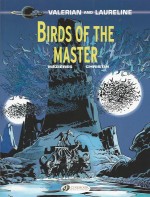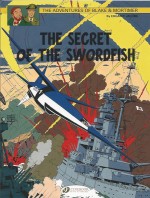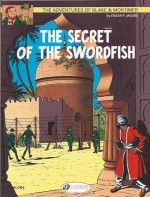
By Richard Marazano & Jean-Michel Ponzio, translated by Jerome Saincantin (Cinebook)
ISBN: 978-1-84918-015-3
Cinebook began publishing The Chimpanzee Complex in 2009 (and we reviewed it here) with the beguiling and enigmatic ‘Paradox’ which introduced the world of tomorrow to a bizarre and baffling cosmic conundrum.
When, six and a half decades after it first returned, the Apollo 11 Command Module splashed down in the Indian Ocean in February 2035, redundant NASA astronaut Helen Freeman was dragooned into joining a top-secret investigation of the incredible passengers, leaving behind in Florida her troubled and too-often neglected daughter Sofia.
Legendary heroes Neil Armstrong and Buzz Aldrin were the first men to walk on the moon, and nobody – including them – had any idea where they’d been for sixty-five years. For the baffled starmen it was only days since their mission began…
On learning that history recorded their triumphant return and unremarkable deaths years later they went ballistic: exhibiting what Freeman described as the traumatic shock response peculiar to space voyagers categorised by NASA as “the Chimpanzee Complexâ€â€¦
The spacers don’t know what happened to “their†third astronaut Michael Collins (if he ever existed). Three heroes landed to be fêted by the world in 1969, but now two of them sit as prisoners in a world that terrified them.
Nobody can explain who or what they might be and no tests science can devise are sufficient to disprove their incredible story…
Compelled to work under Presidential favourite and Top Brass Military Spook Konrad Stealberg, Freeman uncovered even more questions but no answers in her subsequent interviews, until the enigma-nauts finally began to exhibit gaps in memory.
As her best friend NASA bureaucrat Robert Conway struggled to look after the increasingly wayward Sofia, Konrad’s questioning team were presented with another shocking mystery after Armstrong and Aldrin suddenly expired: somehow becoming deteriorated cadavers overnight…
Soon Helen was (only partially) reluctantly piloting a mission to the moon in the mothballed and hastily reconditioned shuttle meant for Mars until budget cuts scotched the project. Her trusted comrades and fellow unemployed astronauts Kurt, Alex and Aleksa were just as delighted to be back in space, but as unhappy and apprehensive as Helen with the military presence and top-secret paraphernalia piled aboard. They were even less sanguine when Stealberg and his creepy elite commandos replaced the regular crew.
En route they discovered the secret history of the 1960s Space Race: America’s black ops space program and the USSR’s clandestine and apparently failed mission to Mars.
Even bigger shocks materialised on the lunar surface when the modern astronauts found the pressure-suited corpses of Aldrin and Armstrong deep in a concealed fissure even as, high above, a vintage Command Module was intercepted by their converted shuttle.
The stellar relic contained Collins’ corpse and an intercepted, decades-old Russian distress call the mission pilot had recorded. The message had been sent by Commies from Mars…
It transpired that NASA has never had the American monopoly on spaceflight: the military had been running a clandestine, parallel program from the very start, funded by siphoning a portion of NASA’s operating budget at the personal instigation of ex-Nazi rocket pioneer Werner von Braun…
Moreover, the 66-year old Russian distress message in the capsule’s primitive computers proved that the Soviets had also been far more committed to space exploration than history books had recorded…
Stealberg took charge, unveiling interplanetary hibernation chambers and turning the now-militarised shuttle-mission towards the Red Planet. Amidst fears of what awaited them, Helen fell into cold sleep, agonising that she had again abandoned and betrayed Sophia as her ship slowly voyaged to Mars and an appointment with the truth, whatever it might be…
The drama recommences in The Sons of Ares as, in October 2035, an increasingly off-the-rails Sophia argues and acts out with Robert Conway whilst in interplanetary space the fourth month of the journey finds American astronauts Paul Dupree and Mark Lawrence taking their boring turn awake for monitor duty whilst their comrades endure resource-saving but life-shortening hibernation…
The monotony is suddenly broken by a freak radiation storm and only one of the terrified explorers makes it to the ship’s shielded area in time…
In Florida Robert is acutely conscious of his failings as a surrogate parent to Sophia, but Helen is blissfully unaware of the personal crisis when the slumbering crew rouse from cold sleep to find Paul insane and Mark missing…
In reporting the situation to Earth, Helen again misses – or perhaps avoids – a chance to speak to Sophia who is gradually coming to terms with the possibility that she might never see her mother again…
As the shuttle at last establishes Mars orbit, Paul is locked up for his own safety and the suspicious voyagers’ peace of mind. Konrad then shares the intel gathered by his agents on Earth whilst they slept. The Soviet clandestine Cosmonaut project began in 1963, headed by space pioneer Yuri Gagarin – whose death had been faked to facilitate his smooth transition to commander of their Mars shot.
Expecting a monumental propaganda coup, the Kremlin simply said nothing when contact was lost with Gagarin’s mission, preferring stolid rhetoric to incontrovertible proof of failure. Now with so many inexplicable events inevitably leading to the Red Planet, Stealberg expects Helen and her team to find all the answers with the Russians’ bodies on the dust surface.
He couldn’t be more wrong…
Locating a base at the polar cap, Konrad dispatches the heavily armed crew to the site even as on Earth, Sophia runs away from home. However even whilst experiencing her greatest desire – walking on another world – Helen can’t help but worry about Paul, doped up and locked into the isolation chamber of the otherwise empty Shuttle…
Whilst Robert frantically searches for Sophia on Earth, the astronauts are astounded to discover the primitive landing site and corpses they expected are, in actuality, a thriving, efficient facility, stuffed with botanical wonders and manned by the very strong and vital cosmonauts who had landed there in the1960s.
After an initial exchange of hostilities – and gunfire – friendly contact is established and another incredible saga unfolds. Russians Vladimir and Borislav have lost all sense of time in the “twelve years†since they landed and Commander Gargarin, having discovered a strange tunnel in a Martian glacier, has been absent for most of that period. They only know he’s still alive because food keeps vanishing…
Stealberg, seeing uncomfortable similarities in the agelessness of the cosmonauts and the duplicate Armstrong and Aldrin on Earth, sedates the Russians, who constantly ramble about the nature of reality, but Helen’s interest is piqued and, with Kurt’s assistance, she sneaks off into the glacier tunnel to find Gagarin…
When she succeeds it only leads to more baffling conundrums. The First Man in Space perpetually stares into the unyielding ice-wall, seemingly unsurprised by Helen’s reports on the Apollo returnees, the impossible time-differentials and the fall of the Soviet Union.
He merely ruminates on Heisenberg’s Uncertainty Principle, and whether such a subatomic phenomenon could apply to larger constructs – such as human beings – in a constant and simultaneous state of being and non-being: a “probability of presenceâ€â€¦
They also talk about children they will probably never see again…
As Helen returns to the greenhouse module, the Russians are planning more armed resistance but Stealberg has an even more pressing problem. Much to Helen’s astonished disbelief, he’s found Gagarin’s sixty-years-dead corpse…
As Vladimir and Borislav attack, setting fire to the modules, the Americans fall back to their vehicle, dragging the hysterical Helen, who had promised her very much alive Yuri Gagarin a ride home…
The tension increases when they re-enter the orbiting Shuttle: Paul has vanished and no trace can be found of him. Thoroughly rattled, Konrad orders an immediate return to Earth, with increased watches for every day of the trip.
May 2036: on Earth Robert has tracked down Sophia and they both eagerly await Helen’s return at Cape Canaveral. However as the Shuttle nears Earth it suddenly vanishes from all tracking systems. Aboard the vessel Helen and Kurt experience the horror of seeing their home planet vanish. Unable to brake the shuttle and with no world in view, they rejoin the others in cold sleep, not knowing when they will next awaken or even if they will still be in their solar system when they do.
Helen’s last conscious thoughts are of the daughter she may never see again…
This astounding hard-science mystery tale steps boldly and confidently into the realm of chilling metaphysics, as the human wide-eyed wonderment gives way to uncanny uncertainty if not outright terror, as Marazano’s pared-down-to-the-bone script is realised with stunning clarity by Ponzio to produce a soaring amalgam of passion, intrigue, and paranoia.
The Chimpanzee Complex is a tale no lover of fantasy and suspense must miss.
© Darguad, Paris, 2008 by Marazano& Ponzio. All rights reserved. English translation © 2009 Cinebook Ltd.











